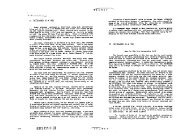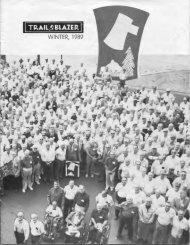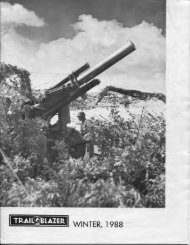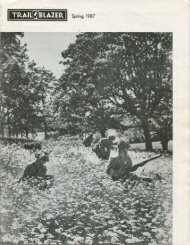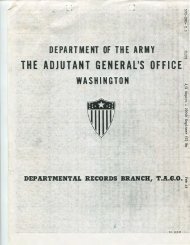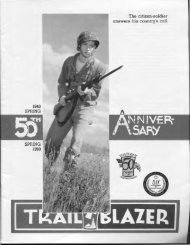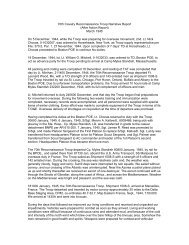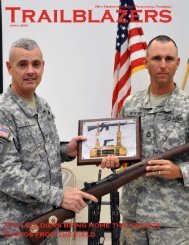Download - 70th Infantry Division Association
Download - 70th Infantry Division Association
Download - 70th Infantry Division Association
Create successful ePaper yourself
Turn your PDF publications into a flip-book with our unique Google optimized e-Paper software.
S-2 records showed 464 prisoners taken by the 276th <strong>Infantry</strong> Regiment during the month.<br />
Combat efficiency was rated as: Excellent.<br />
By <strong>Division</strong> order the 276th <strong>Infantry</strong> Regiment was preparing to move during the night of 31 March - 1<br />
April from the Reichenbach area to the vicinity of Rheinbollen. The move began by motor in the morning<br />
hours of 1 April 1945, the first elements departing about 0730.<br />
Our new area was generally along the west bank of the Rhein River from Boppard to Bacharach, a<br />
distance of 15 miles, and ex- tending inland six to eight miles in depth. Our mission was to guard the Main<br />
Supply Routes, the bridges across the Rhein, and the supply points within our boundaries.<br />
The Regimental CP opened in Rheinbollen, Germany at 1320 on the 1st of April. The 2d Battalion was<br />
located in the vicinity of Werlau, the 3d Battalion in the vicinity of Daxweiler, and the 1st Battalion closed<br />
into St Goar shortly after midnight. The first few days of the month were spent in reconnaissance and<br />
organization to determine the best method to carry out our mission. S-2 organized motor and foot patrols<br />
to check the roads, patrol the woods, and enforce Army Military Government regulations. Motorized<br />
patrols were in action 24 hours a day. The prisoner interrogation team immediately began to screen<br />
civilians for possible Volkstrum troops, deserters from the German Army, and to segregate the displaced<br />
persons.<br />
The 1st Battalion relieved elements of the 2<strong>70th</strong> Field Artillery on Rhein River Bridge 271 at St Goar, and<br />
the 2d Battalion assumed the responsibility for Bridge 270 across the Rhein at Boppard and moved its CP<br />
from Werlau to Boppard.<br />
We were assisted in our mission by elements of the 565 AntiAircraft Battalion, 1152 Engineers, 1134<br />
Engineers, and 512 Military Police. Radar, searchlights, anti-aircraft guns, plus our own anti-tank guns,<br />
cannon, and mortars were all placed to best defend the bridges from any possible air or land attack.<br />
We were notified that the 276th Regiment as a part of the <strong>70th</strong> <strong>Division</strong> was assigned to the Third Army<br />
after having been in the Seventh Army since the <strong>Division</strong> first arrived in France in December 1944. In<br />
addition, the <strong>70th</strong> <strong>Division</strong> was under orders of SHAEF (Supreme Headquarters Allied Expeditionary<br />
Forces) in that the <strong>Division</strong> as a unit could not cross the Rhein River without SHAEF approval.<br />
April 1, 1945 - Holzfeldt, Germany. Record of events: Company moved fr Kottweiler, Germany to<br />
Holzfeldt, Germany by motor, a distance of 85 miles.<br />
April 2, 1945 - Filsen, Germany. Record of events: Company moved by motor convoy to Filsen, Germany,<br />
Second Platoon manning positions, a distance of 10 miles.<br />
April 3, 1945 - Filsen, Germany. Record of events: Second Platoon moved to Kamp, Germany (80.8 -<br />
91.6) Bonnard 1/25,000 and are manning outposts there. Remainder of Company continuing to man<br />
outposts and guard bridges and send out motorized patrols. The 3d Battalion moved its CP from<br />
Daxweiler to Weiler on 3 April. Operations throughout the Regiment consisted of carrying out the<br />
Regimental mission.<br />
Patrols from Company K, in clearing cut a section of woods, were fired upon by two SS troopers with a<br />
"Burp" gun. They were both killed by Pfc George L. Hibbs, 2d Platoon, Company K, firing his M1. A third<br />
member was captured and processed by the Interrogation team. The prisoner stated that they had been<br />
left behind to harass the Americans by sniping, cutting communication wires, etc. The <strong>Division</strong><br />
Commanding General sent his congratulations to all men concerned for the "prompt liquidation of the<br />
enemy".<br />
On 3 April 1945 Colonel A. C. Morgan, the Regimental Commander, was taken ill and entered an Army<br />
hospital. Lt. Colonel Gordon Hammond assumed command of the Regiment.



